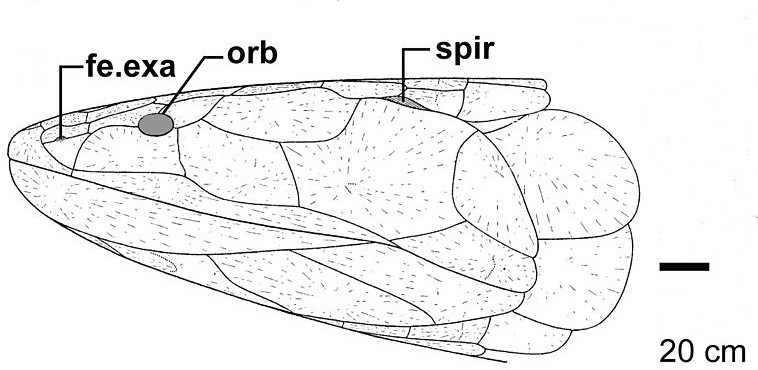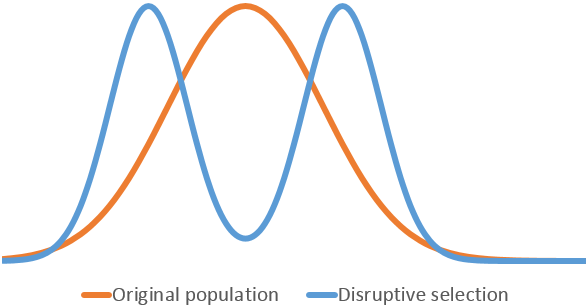|
Eusthenodon
''Eusthenodon'' (Greek for “strong-tooth” – ''eustheno''- meaning “strength”, -''odon'' meaning “tooth”) is an extinct genus of tristichopterid tetrapodomorphs from the Devonian, Late Devonian period, ranging between 383 and 359 million years ago (Frasnian to Famennian). They are well known for being a cosmopolitan genus with remains being recovered from East Greenland, Australia, Central Russia, South Africa, Pennsylvania, and Belgium. Compared to the other closely related genera of the Tristichopteridae clade, ''Eusthenodon'' was one of the largest Sarcopterygii, lobe-finned fishes (approximately 2.5 meters in length) and among the most derived tristichopterids alongside its close relatives ''Cabonnichthys'' and ''Mandageria''. The large size, predatory ecology, and evolutionarily derived characters possessed by ''Eusthenodon'' likely contributed to its ability to occupy and flourish in the numerous localities across the world mentioned above. ''Eusthenodon'' is a ... [...More Info...] [...Related Items...] OR: [Wikipedia] [Google] [Baidu] |
Eusthenodon DB15
''Eusthenodon'' (Greek for “strong-tooth” – ''eustheno''- meaning “strength”, -''odon'' meaning “tooth”) is an extinct genus of tristichopterid tetrapodomorphs from the Late Devonian period, ranging between 383 and 359 million years ago (Frasnian to Famennian). They are well known for being a cosmopolitan genus with remains being recovered from East Greenland, Australia, Central Russia, South Africa, Pennsylvania, and Belgium. Compared to the other closely related genera of the Tristichopteridae clade, ''Eusthenodon'' was one of the largest lobe-finned fishes (approximately 2.5 meters in length) and among the most derived tristichopterids alongside its close relatives ''Cabonnichthys'' and ''Mandageria''. The large size, predatory ecology, and evolutionarily derived characters possessed by ''Eusthenodon'' likely contributed to its ability to occupy and flourish in the numerous localities across the world mentioned above. ''Eusthenodon'' is attributed to being just ... [...More Info...] [...Related Items...] OR: [Wikipedia] [Google] [Baidu] |
Tristichopterid
Tristichopterids (Tristichopteridae) were a diverse and successful group of tetrapodomorph fishes living throughout the Middle and Late Devonian. They first appeared in the Eifelian stage of the Middle Devonian. Within the group sizes ranged from a few tens of centimeters (''Tristichopterus'') to several meters (''Hyneria'' and ''Eusthenodon''). Some tristichopterids share some of the features of the elpistostegalians, a diverse clade of fishes close to the origin of (and including) tetrapods. This mainly concerns the shape of the skull and a reduction in size of the posterior fins. An old and persistent notion is that ''Eusthenopteron'' was able to crawl onto land using its fins. However, there is no evidence actually supporting this idea.M. Laurin, F. J. Meunier, D. Germain, and M. Lemoine 2007A microanatomical and histological study of the paired fin skeleton of the Devonian sarcopterygian ''Eusthenopteron foordi Journal of Paleontology'' 81: 143–153. All tristichopterids h ... [...More Info...] [...Related Items...] OR: [Wikipedia] [Google] [Baidu] |
Tetrapodomorph
The Tetrapodomorpha (also known as Choanata) are a clade of vertebrates consisting of tetrapods (four-limbed vertebrates) and their closest sarcopterygian relatives that are more closely related to living tetrapods than to living lungfish. Advanced forms transitional between fish and the early labyrinthodonts, such as ''Tiktaalik'', have been referred to as "fishapods" by their discoverers, being half-fish, half-tetrapods, in appearance and limb morphology. The Tetrapodomorpha contains the crown group tetrapods (the last common ancestor of living tetrapods and all of its descendants) and several groups of early stem tetrapods, which includes several groups of related lobe-finned fishes, collectively known as the osteolepiforms. The Tetrapodamorpha minus the crown group Tetrapoda are the Stem Tetrapoda, a paraphyletic unit encompassing the fish to tetrapod transition. Among the characteristics defining tetrapodomorphs are modifications to the fins, notably a humerus with convex he ... [...More Info...] [...Related Items...] OR: [Wikipedia] [Google] [Baidu] |
Tetrapod
Tetrapods (; ) are four-limbed vertebrate animals constituting the superclass Tetrapoda (). It includes extant and extinct amphibians, sauropsids ( reptiles, including dinosaurs and therefore birds) and synapsids (pelycosaurs, extinct therapsids and all extant mammals). Tetrapods evolved from a clade of primitive semiaquatic animals known as the Tetrapodomorpha which, in turn, evolved from ancient lobe-finned fish (sarcopterygians) around 390 million years ago in the Middle Devonian period; their forms were transitional between lobe-finned fishes and true four-limbed tetrapods. Limbed vertebrates (tetrapods in the broad sense of the word) are first known from Middle Devonian trackways, and body fossils became common near the end of the Late Devonian but these were all aquatic. The first crown-tetrapods (last common ancestors of extant tetrapods capable of terrestrial locomotion) appeared by the very early Carboniferous, 350 million years ago. The specific aquatic ancestors ... [...More Info...] [...Related Items...] OR: [Wikipedia] [Google] [Baidu] |
Old Red Sandstone
The Old Red Sandstone is an assemblage of rocks in the North Atlantic region largely of Devonian age. It extends in the east across Great Britain, Ireland and Norway, and in the west along the northeastern seaboard of North America. It also extends northwards into Greenland and Svalbard. These areas were a part of the ancient continent of Euramerica, Euramerica/Laurussia. In Britain it is a lithostratigraphy, lithostratigraphic unit (a sequence of rock strata) to which Stratigraphy, stratigraphers accord Geological unit#Lithostratigraphic units, supergroup status and which is of considerable importance to early paleontology. For convenience the short version of the term, ORS is often used in literature on the subject. The term was coined to distinguish the sequence from the younger New Red Sandstone which also occurs widely throughout Britain. Sedimentology The Old Red Sandstone describes a suite of sedimentary rocks deposited in a variety of environments during the Devonian ... [...More Info...] [...Related Items...] OR: [Wikipedia] [Google] [Baidu] |
Sarcopterygii
Sarcopterygii (; ) — sometimes considered synonymous with Crossopterygii () — is a taxon (traditionally a class or subclass) of the bony fishes known as the lobe-finned fishes. The group Tetrapoda, a mostly terrestrial superclass including amphibians, sauropsids (reptiles, including dinosaurs and therefore birds) and synapsids (with mammals being the only extant group), evolved from certain sarcopterygians; under a cladistic view, tetrapods are themselves considered a subgroup within Sarcopterygii. The known extant non-tetrapod sarcopterygians include two species of coelacanths and six species of lungfishes. Characteristics Early lobe-finned fishes are bony fish with fleshy, lobed, paired fins, which are joined to the body by a single bone. The fins of lobe-finned fishes differ from those of all other fish in that each is borne on a fleshy, lobelike, scaly stalk extending from the body. The scales of sarcopterygians are true scaloids, consisting of lamellar bone sur ... [...More Info...] [...Related Items...] OR: [Wikipedia] [Google] [Baidu] |
Cabonnichthys
''Cabonnichthys'' ("Burns' Cabonne fish") is an extinct genus of tristichopterid fish that lived in the Late Devonian period (Famennian) of Australia Australia, officially the Commonwealth of Australia, is a Sovereign state, sovereign country comprising the mainland of the Australia (continent), Australian continent, the island of Tasmania, and numerous List of islands of Australia, sma .... It has been found in Canowindra and is a medium-sized carnivorous lobe-finned fish. References Tristichopterids Prehistoric lobe-finned fish genera Late Devonian animals Late Devonian fish Devonian bony fish Prehistoric fish of Australia {{paleo-lobefinned-fish-stub ... [...More Info...] [...Related Items...] OR: [Wikipedia] [Google] [Baidu] |
Mandageria
''Mandageria fairfaxi'' (Pronunciation: Man-daj-ee-ree-a fair-fax-i) is an extinct lobe-finned fish that lived during the Late Devonian period (Frasnian – Famennian). It is related to the much larger ''Hyneria''; although ''Mandageria'' was smaller, it probably hunted in the same way. The generic epithet, ''Mandageria'', refers to the Mandagery Sandstone, outcropping near Canowindra, Australia, where the fossils were found. The specific epithet, ''fairfaxi'', honors the philanthropist James Fairfax. ''M. fairfaxi'' is the state fossil emblem for New South Wales. Description ''Mandageria'' was a large predator about long. It had a long torpedo-shaped body and large tail fins. ''Mandageria'' also had large pectoral fins which could have helped it manoeuvre around submerged logs when preparing to attack its prey. ''Mandageria'' had a functional neck joint, an otherwise uncommon feature among fish - ''Tiktaalik'', '' Tarrasius'', placoderms (esp. Arthrodira) and seahorses A ... [...More Info...] [...Related Items...] OR: [Wikipedia] [Google] [Baidu] |
Ecology
Ecology () is the study of the relationships between living organisms, including humans, and their physical environment. Ecology considers organisms at the individual, population, community, ecosystem, and biosphere level. Ecology overlaps with the closely related sciences of biogeography, evolutionary biology, genetics, ethology, and natural history. Ecology is a branch of biology, and it is not synonymous with environmentalism. Among other things, ecology is the study of: * The abundance, biomass, and distribution of organisms in the context of the environment * Life processes, antifragility, interactions, and adaptations * The movement of materials and energy through living communities * The successional development of ecosystems * Cooperation, competition, and predation within and between species * Patterns of biodiversity and its effect on ecosystem processes Ecology has practical applications in conservation biology, wetland management, natural resource managemen ... [...More Info...] [...Related Items...] OR: [Wikipedia] [Google] [Baidu] |
Late Devonian
The Devonian ( ) is a geologic period and system of the Paleozoic era, spanning 60.3 million years from the end of the Silurian, million years ago (Mya), to the beginning of the Carboniferous, Mya. It is named after Devon, England, where rocks from this period were first studied. The first significant adaptive radiation of life on dry land occurred during the Devonian. Free-sporing vascular plants began to spread across dry land, forming extensive forests which covered the continents. By the middle of the Devonian, several groups of plants had evolved leaves and true roots, and by the end of the period the first seed-bearing plants appeared. The arthropod groups of myriapods, arachnids and hexapods also became well-established early in this period, after starting their expansion to land at least from the Ordovician period. Fish reached substantial diversity during this time, leading the Devonian to often be dubbed the Age of Fishes. The placoderms began dominating al ... [...More Info...] [...Related Items...] OR: [Wikipedia] [Google] [Baidu] |
Genetic Divergence
Genetic divergence is the process in which two or more populations of an ancestral species accumulate independent genetic changes (mutations) through time, often leading to reproductive isolation and continued mutation even after the populations have become Reproductive isolation, reproductively isolated for some period of time, as there isn’t genetic exchange anymore. In some cases, subpopulations living in ecologically distinct peripheral environments can exhibit genetic divergence from the remainder of a population, especially where the range of a population is very large (see parapatric speciation). The genetic differences among divergent populations can involve silent mutations (that have no effect on the phenotype) or give rise to significant Morphology (biology), morphological and/or physiology, physiological changes. Genetic divergence will always accompany reproductive isolation, either due to novel adaptations via selection and/or due to genetic drift, and is the principal ... [...More Info...] [...Related Items...] OR: [Wikipedia] [Google] [Baidu] |
Morphology (biology)
Morphology is a branch of biology dealing with the study of the form and structure of organisms and their specific structural features. This includes aspects of the outward appearance (shape, structure, colour, pattern, size), i.e. external morphology (or eidonomy), as well as the form and structure of the internal parts like bones and organs, i.e. internal morphology (or anatomy). This is in contrast to physiology, which deals primarily with function. Morphology is a branch of life science dealing with the study of gross structure of an organism or taxon and its component parts. History The etymology of the word "morphology" is from the Ancient Greek (), meaning "form", and (), meaning "word, study, research". While the concept of form in biology, opposed to function, dates back to Aristotle (see Aristotle's biology), the field of morphology was developed by Johann Wolfgang von Goethe (1790) and independently by the German anatomist and physiologist Karl Friedrich Burdach ... [...More Info...] [...Related Items...] OR: [Wikipedia] [Google] [Baidu] |





.jpg)

